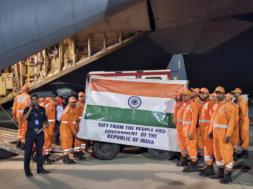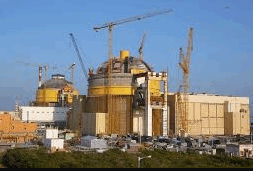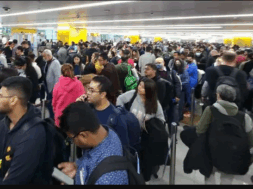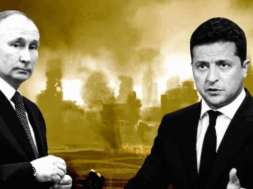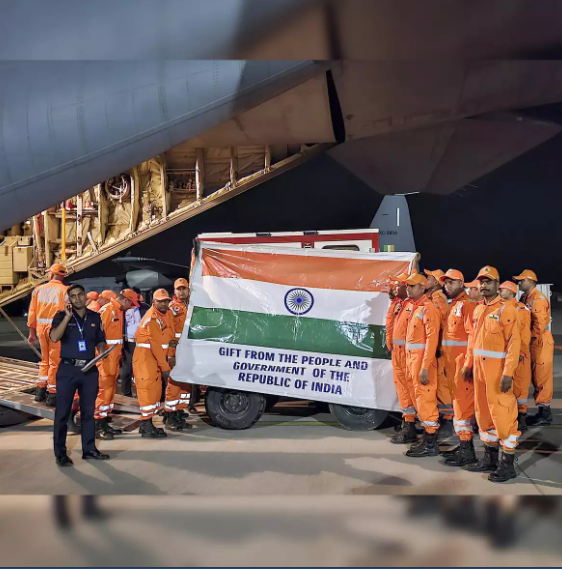
India Dispatched 2 More Ships with Relief Materials to Myanmar, Death Toll Crosses 1,700
Manas Dasgupta
NEW DELHI, Mar 30: India has dispatched two more Navy ships carrying relief materials to the earthquake-hit Myanmar where the death toll has mounted to over 1,700 with nearly 4,000 people injured.
Across the border in Thailand, rescuers in Bangkok worked Sunday to pluck out survivors trapped in a 30-storey skyscraper under construction collapsed after the Friday earthquake. At least 18 people have been killed in the Thai capital, city authorities said on Sunday, with 32 injured and 83 still missing.
Myanmar was hit by a powerful 7.7 magnitude earthquake and aftershocks at midday on Friday with its epicentre in the vicinity of Mandalay, tearing apart structures, smashing highways and trapping people under rubble.
Amid demands for international assistance, India launched “Operation Brahma” on Saturday to provide humanitarian aid to the quake-hit country. India has already sent two C-17 military aircraft with a field hospital and 118-member staff, along with essential items such as medicines and ready-to-eat food.
Taking to X, External Affairs Minister S Jaishankar on Sunday said two Indian Navy ships – INS Karmuk and LCU 52 – were headed to Yangon carrying 30 tonnes of disaster relief and medical supplies.
India had also dispatched INS Satpura and INS Savitri to the Yangon port on Saturday with 40 tonnes of humanitarian aid. India’s ambassador in Myanmar was in the capital Naypyidaw to coordinate the relief efforts, according to the Ministry of External Affairs.
Myanmar had been reeling under a prolonged civil war, which has already caused a humanitarian crisis. The situation has made it both difficult and dangerous for movement around the country, hindering relief efforts and raising fears of a rise in the death toll.
After anti-coup fighters declared a partial ceasefire, international aid has started to trickle in, although it might be too late. The Indian Army first dispatched an aircraft carrying 15 tonnes of relief material. These material include tents, blankets, essential medicines, tarpaulins, sleeping bags, generator sets, solar lamps, food packets and kitchen sets.
The second tranche of aid included 80 NDRF search and rescue team personnel and specialists, while the third comprised a field hospital with a team of specialists, doctors and medics. India shares a 1,643-kilometre-long border with Myanmar on the eastern side.
Prime Minister Narendra Modi also spoke to Senior General Min Aung Hlaing on Saturday and conveyed deepest condolences on behalf of the people and the Government of India for the loss of lives. He also conveyed that “we stand in solidarity with the government and the people of Myanmar and that we would do our best to provide relief, rescue and whatever assistance required to deal with this calamity.”
As rescue efforts continue in Myanmar, the smell of decaying bodies permeated the streets of Myanmar’s second-largest city on Sunday, media reports said. Bodies were seen rotting in the sun and survivors cried out for their loved ones as the impoverished nation was on the verge of collapse.
China has also sent 135 rescuers and $13.8 million worth of emergency relief. Russia, Singapore, and Malaysia have also offered assistance, but with roads impassable and airports disabled, getting supplies in has become a logistical nightmare. The UN said a severe lack of medical equipment was hindering Myanmar’s response to the quake, while aid agencies have warned that the country was unprepared to deal with a disaster of this magnitude. The International Federation of Red Cross and Red Crescent Societies on Sunday launched an emergency appeal for more than $100 million to help victims.
Relief efforts have been hampered by buckled roads, downed bridges, spotty communications and the challenges of operating in a country in the midst of a civil war. The search for survivors has been primarily conducted by the local residents without the aid of heavy equipment, moving rubble by hand and with shovels in 41-degree Celsius heat, with only the occasional tracked excavator to be seen.
Aftershocks, most recently a 5.1 magnitude quake late Sunday afternoon, pushed frantic masses into the streets—only for them to relapse a short while later under the faint prospect of discovering something living.
“It’s a nightmare. The city is destroyed. Dead bodies are all around. We hear screams beneath the wreckage, but we can’t reach them in time,” cried Kyaw Min, a resident volunteer, his hands raw and bleeding from digging for hours.
At a destroyed Buddhist examination hall in Mandalay, Myanmar and Chinese responders worked to find buried victims on Sunday. The UN said a severe lack of medical equipment was hindering Myanmar’s response to the quake. Some 3.5 million people were displaced by the raging civil war, many at risk of hunger, even before the quake struck. The military in Myanmar has been involved in a civil war on multiple fronts since it overthrew Aung San Suu Kyi’s civilian government in February 2021.
The Indian Army said a specialised rescue team from 50 (I) Para Brigade has been deployed to Myanmar under Operation Brahma. The Army said 118 personnel, including medical and communication units, landed at the Naypyidaw International Airport at 11.30 pm (Myanmar time) on Saturday.
“Mandalay, located 160 miles north of the current base, has been identified as the primary area of operations. The team will commence movement towards Mandalay by 1100 hours. While aerial insertion remains a key mode of deployment, parallel road-based induction is also being explored to establish the Operation Theatre (OT) at Mandalay in the shortest possible time,” the Army said in a statement.
Most residents in Mandalay spent the night sleeping on the streets, either left homeless by the quake or worried that the continuing aftershocks might cause structures left unstable to collapse. A 5.1 magnitude aftershock Sunday afternoon prompted screams from those in the streets, and then the work continued.
Satellite images of Myanmar show the aftermath of the earthquake that damaged critical infrastructure, including airports, highways, and bridges, hindering the delivery of much-needed humanitarian aid. They also show destruction and devastation at the Masoeyein Monastery and surrounding areas, where historical infrastructure and vegetation have been impacted. But the true scale of the disaster remains unclear in the isolated military-ruled state, and the toll is likely to rise significantly.
Junta chief Min Aung Hlaing also issued an exceptionally rare appeal for international aid on Friday, indicating the severity of the calamity. Previous military governments have shunned foreign assistance, even after major natural disasters.
Myanmar has already been ravaged by four years of civil war sparked by a military coup in 2021. Anti-junta fighters in the country have declared a two-week partial ceasefire in quake-affected regions starting Sunday, the shadow “National Unity Government” said in a statement.
